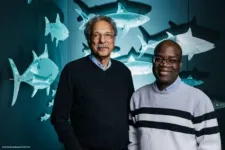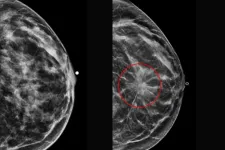(Press-News.org) In a new study published in Nature Communications, a team of researchers at the Carl R. Woese Institute for Genomic Biology report a new, robust computational toolset to extract biological relationships from large transcriptomics datasets. These efforts will help scientists better investigate cellular processes.
Living organisms are governed by their genome—an instruction manual written in the language of DNA that dictates how an organism grows, survives, and reproduces. By regulating the abundance of different RNA transcripts, cells control their protein expression level, thereby shaping their functions and responses to the environment. Transcriptomics is the study of gene expression through cataloging the presence and abundance levels of active RNA transcripts generated from the genome under different conditions. Through the lens of RNA, transcriptomics technologies allow scientists to study the complex interactions that enable life and cause disease, as well as assess the biological effects of therapeutics.
Imaging-based spatial transcriptomics technologies are powerful methods to map the locations of hundreds to thousands of RNA transcripts within tissues to investigate the spatial organization of molecules and cells across tissues.
“It's a completely new way of probing molecular interactions,” said Hee-Sun Han (IGOH/GNDP), a professor of chemistry at the University of Illinois Urbana-Champaign. “Although we are getting a spatial map of molecules, like a really detailed Google Map, the community is not really clear on how to utilize the dataset. In this study, we utilize the co-localization pattern of molecules to identify potentially interacting molecular pairs and infer their functions. This is the beginning of our long journey to think about what information is embedded in this space.”
After connecting through the IGB’s Gene Networks in Neural and Development Plasticity Research Theme, Han teamed up with Dave Zhao (GNDP), a professor of statistics at Illinois, and Saurabh Sinha, a former Illinois professor and current professor of biomedical engineering at the Georgia Institute of Technology. Using Han’s knowledge of the technology and Sinha and Zhao’s expertise in genomics analysis and statistics, they developed InSTAnT, an intracellular spatial transcriptomics toolkit.
“I would say that the fundamental model of a cell can be thought of in terms of how its internal components are situated relative to each other, and not just how much of each there is. The toolkit allows you to break down these complicated biological systems into their smallest, most irreducible parts. Our new idea was to not so much look at where these smallest components are located, but instead how they are located with respect to each other,” Zhao said.
InSTAnT uses robust statistical tests and algorithms to identify proximal pairs—RNA transcripts located in close proximity. By finding these proximal pairs, InSTAnT offers new insights into sets of molecules that tend to work together, which can help scientists begin to understand their functions.
“As an analogy, let's say we don't really know anything about how society functions. Who people interact with forms the basis of the function of the society. So, if we want to learn who is interacting with each other, what the functional units are, and what these units do, we can look at their relative location,” Han said.
Following this analogy, if one took photos of proximal pairs of people at different times of day, they could learn about their relationships and roles in society when analyzing the data. If people are located together during the day in Urbana, it could suggest that they are coworkers at Illinois. But if people tend to colocalize at night, it could indicate that they are roommates or family members.
This is the basis of InSTAnT’s technology. By looking at the simplest components of a complex system, one can begin to understand how complicated phenomena emerge. The InSTAnT toolkit also tests if a proximal pairs’ sub-cellular colocalization shows any tissue-level spatial patterns, further adding to the benefits of using this technology. But while the underlying principles of identifying proximal pairs and searching for their colocalization patterns may sound simple, in practice InSTAnT is a highly complex statistical tool that was challenging to develop.
“We drew inspiration from spatial statistics that have been developed for other contexts, such as ecology. While describing molecules inside a cell can be likened to describing trees in a region, there are unique differences such as the peculiarity and heterogeneity of cells that did not allow us to just use those statistics for the modeling. So, we had to draw on completely different models, even non-spatial statistics, and combined these with spatial ideas to do the final modeling,” said Sinha, the lead researcher on the project. Sinha credits Anurendra Kumar, a graduate student in his research group and first author of the paper, for driving this challenging project and bringing InSTAnT to life.
Another key component of the InSTAnT toolkit is its accuracy and statistical rigor, especially when compared to existing tools. InSTAnT provides reproducible findings while maintaining a low rate of false positives when identifying proximal pairs. They accomplished this high robustness by leveraging team science.
“One of the nice things about this team is that we were able to do both experimental and analytical work by collaborating. The Han group generated extra data in the lab so we could validate and test this tool. The ability to look at these robustness metrics, not just analytically or with simulated data, but also with real in vitro experimental data, is a big strength,” Zhao said.
The trio of professors acknowledged that the collective, collaborative efforts of their students was important to successfully pull off this multi-lab project. But as this chapter closes with the publication of the InSTAnT toolkit, this team’s work is not done.
Han said, “I got to know Saurabh and Dave through this collaboration, and we're developing new projects to tackle more grand challenge problems. This requires a multi-pronged approach that uses all of our different expertise. So to me, this is just the beginning of our exciting work together.”
The publication, “Intracellular spatial transcriptomic analysis toolkit (InSTAnT)” can be found at https://doi.org/10.1038/s41467-024-49457-w and was funded by the National Institutes of Health, Johnson & Johnson, and the Cancer Center at Illinois.
END
IGB researchers leverage team science to develop InSTAnT Toolkit
2024-12-05
ELSE PRESS RELEASES FROM THIS DATE:
AADOCR elects new Vice-president, Treasurer, and Representative to the IADR/AADOCR Publications Committee
2024-12-05
Alexandria, VA – Members of the American Association for Dental, Oral, and Craniofacial Research (AADOCR) have elected Margherita R. Fontana, University of Michigan, Ann Arbor, as Vice-president, Julie Frantsve-Hawley, Temple University Kornberg School of Dentistry, Philadelphia, PA, as Treasurer, and Ariadne Letra, University of Pittsburgh School of Dental Medicine, PA, as Representative to the IADR/AADOCR Publications Committee. Their terms will commence at the conclusion of the 54th Annual Meeting ...
IADR elects Raul Garcia as Vice-president
2024-12-05
Alexandria, VA, USA – Members of the International Association for Dental, Oral, and Craniofacial Research (IADR) have elected Raul I. Garcia, Boston University, USA, to serve as Vice-president. His term will commence at the conclusion of the 103rd General Session of the IADR, which will be held in conjunction with the 2025 IADR Pan European Regional Congress from June 25-28, 2025 in Barcelona, Spain.
Garcia is Professor and Chair of the Department of Health Policy and Health Services Research at the Henry M. Goldman School of Dental Medicine at Boston University. He received his DMD and MMedSc from the Harvard ...
Seven researchers named to Battelle Distinguished Inventor cadre
2024-12-05
Seven scientists affiliated with the Department of Energy’s Oak Ridge National Laboratory have been named Battelle Distinguished Inventors in recognition of being granted 14 or more United States patents. Since Battelle began managing ORNL in 2000, 104 ORNL researchers have reached this milestone.
“These innovators have not only developed cutting-edge technologies, but they have also prioritized taking the steps to move them out into the marketplace, which is critical for adoption and broad impact,” said Susan Hubbard, ORNL deputy for science and technology. “The innovators are working on a range of strategies important for our ...
Gene therapy fixes major cause of stillbirth, premature birth in guinea pig model
2024-12-05
The life of billions of people inhabiting Earth is owed to a temporary organ that supported and nourished them in a mother’s womb.
The placenta, or afterbirth, is considered sacred by some cultures, its pivotal role in pregnancy recognized as far back as the raising of Egypt’s pyramids. It provides nutrients and oxygen to the fetus via the umbilical cord, acting like a gut, kidney, liver, and lungs.
If the placenta fails, only one hazardous option remains — premature delivery through induced labor or cesarean delivery.
Now, the first therapy to potentially ...
From one gene switch, many possible outcomes
2024-12-05
Within all complex, multicellular living systems such as plants and humans, there exists a set of genetic elements that can be likened to the blueprints, tools, and specialized personnel at a construction site for an expanding development. Plant biologists like Aman Husbands at the University of Pennsylvania study a family of skilled subcontractors, known as the HD-ZIPIII transcription factors (TFs). These subcontractors are tasked with deciding which blueprints, or genes, to follow as they guide the ...
Visiting Fellows selected for inaugural cohort of the Africa-UBC Oceans and Fisheries Visiting Fellows Program
2024-12-05
The Africa-UBC Oceans and Fisheries Visiting Fellows Program is extremely pleased to announce the selection of its inaugural laureates: Dr. Cynthia A. Adinortey (Ghana) and Dr. Antony Otinga Oteng’o (Kenya).
“We had many excellent applicants from across Sub-Saharan Africa. Ultimately, our Selection Committee selected these two exemplary scholars, and we are most happy with the result,” said Dr. William Cheung, professor and Director of UBC’s Institute for the Oceans and Fisheries (IOF), which administers the Program. “These two exemplary scholars will now have the opportunity to collaborate ...
Innovative immunotherapy shows promise in early clinical trial for breast cancer
2024-12-05
A groundbreaking phase one clinical trial exploring a novel cell-based immunotherapy for breast cancer has been accepted for publication in JAMA Oncology. The technology tested in the trial was co-developed by Gary Koski, Ph.D., professor in Kent State University’s Department of Biological Sciences, and Brian J. Czerniecki, M.D., Ph.D., chair and senior member in the Moffitt Cancer Center’s Department of Breast Oncology. The study focuses on a new treatment approach that aims to harness the body’s immune system to enhance patient responses ...
Whiteness as a fundamental determinant of health in rural America
2024-12-05
WASHINGTON -- White people in rural America have unique factors that drive worse health outcomes than their urban counterparts, prompting a team of public health researchers to label whiteness as a fundamental determinant of health. They say while the health and well-being of racially minoritized populations should continue to be a research priority they urge researchers to consider factors that influence the health of majoritized populations.
In an analytic essay, "Whiteness: A Fundamental Determinant of the Health of Rural White Americans,” published Dec. 5 in the American Journal of Public Health, Caroline Efird, PhD, MPH, ...
Analyzing multiple mammograms improves breast cancer risk prediction
2024-12-05
A new study from Washington University School of Medicine in St. Louis describes an innovative method of analyzing mammograms that significantly improves the accuracy of predicting the risk of breast cancer development over the following five years. Using up to three years of previous mammograms, the new method identified individuals at high risk of developing breast cancer 2.3 times more accurately than the standard method, which is based on questionnaires assessing clinical risk factors alone, such as age, race and family history of breast cancer.
The study is published ...
Molecular zip code draws killer T cells straight to brain tumors
2024-12-05
More information, including a copy of the paper, can be found online at the Science press package at https://www.eurekalert.org/press/scipak.
Molecular Zip Code Draws Killer T Cells Straight to Brain Tumors
Researchers have found a way to program immune cells to attack glioblastoma and treat the inflammation of multiple sclerosis in mice. The technology will soon be tested in a clinical trial for people with glioblastoma.
UCSF scientists have developed a “molecular GPS” to guide immune cells into the brain and kill tumors without harming healthy tissue.
This living cell therapy can navigate through the body to a specific organ, addressing ...







